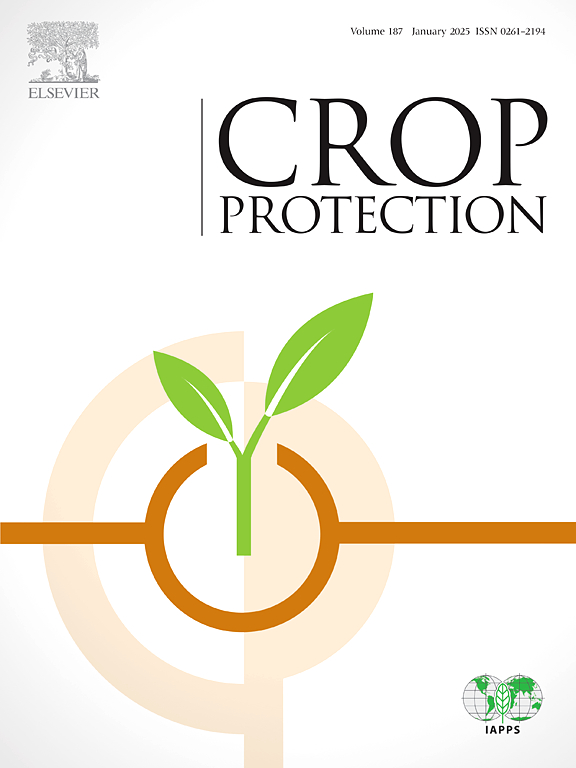印度尼西亚几种谷物品种对玉米象甲的抗性研究(鞘翅目:粟象科)
IF 2.5
2区 农林科学
Q1 AGRONOMY
引用次数: 0
摘要
玉米象甲,玉米象甲(鞘翅目:粟象科),是谷物的主要害虫和内部食料,对包括印度尼西亚在内的世界各地造成重大经济损失。本研究评估了玉米象鼻虫对印尼几种谷物的寄主偏好和生物学性能,包括精米(IR64)、去壳米(Mekongga)、玉米种子(Jakarin)和高粱种子(Soper 7)。在自由选择偏好测试中,成年象鼻虫最喜欢的寄主是高粱种子,其次是精米、玉米种子和去壳米。抗生素敏感性指数表明,去皮水稻和玉米种子对该病菌有抗性,精米和高粱种子对该病菌有敏感性。玉米玉米成虫前期(38.11 ~ 43.43 d)和发育中期(30.13 ~ 41.63 d)与籽粒单宁、酚类物质和碳水化合物含量呈正相关。籽粒含水量与籽粒硬度、籽粒脂肪含量呈负相关,与籽粒硬度、籽粒脂肪含量呈负相关。此外,去壳水稻的种皮对玉米螟取食和产卵具有抑制作用。因此,玉米玉米蚜的寄主偏好和生物学特性与被试谷物的理化特性有关。因此,评估谷物对玉米玉米螟的易感性是制定有效的综合虫害管理策略以减轻该害虫的经济影响的基础。本文章由计算机程序翻译,如有差异,请以英文原文为准。
Resistance of several Indonesian cereal grain cultivars to the maize weevil, Sitophilus zeamais (Motschulsky) (Coleoptera: Curculionidae)
The maize weevil, Sitophilus zeamais (Motschulsky) (Coleoptera: Curculionidae), is a primary pest and internal feeder of cereal grains, responsible for substantial economic losses worldwide, including in Indonesia. This study assessed the host preference and biological performance of the maize weevil on several Indonesian cereal grains, including milled rice (IR64), unhulled rice (Mekongga), maize seed (Jakarin), and sorghum seed (Soper 7). In a free-choice preference test, sorghum seed was the most preferred host for adult weevils to feed on and lay eggs, followed by milled rice, maize seed, and unhulled rice. The susceptibility index from the antibiosis test indicated that unhulled rice and maize seed were resistant, whereas milled rice and sorghum seed were classified as susceptible. The preadult period (38.11–43.43 days) and median development period (30.13–41.63 days) of S. zeamais were positively correlated with tannin, phenolic, and carbohydrate contents in the grains. Conversely, the preadult period, median development period, and F1 progeny were negatively correlated with grain hardness and lipid content, while grain moisture content showed a negative correlation with the preadult period and median development period. Additionally, the seed coat on unhulled rice appeared to act as a barrier that inhibited feeding and oviposition by S. zeamais. Therefore, the host preference and biology of S. zeamais were associated with the physicochemical properties of the evaluated cereal grains. Consequently, evaluating the susceptibility of cereal grains to S. zeamais is fundamental for developing effective integrated pest management strategies to mitigate the economic impact of this pest.
求助全文
通过发布文献求助,成功后即可免费获取论文全文。
去求助
来源期刊

Crop Protection
农林科学-农艺学
CiteScore
6.10
自引率
3.60%
发文量
200
审稿时长
29 days
期刊介绍:
The Editors of Crop Protection especially welcome papers describing an interdisciplinary approach showing how different control strategies can be integrated into practical pest management programs, covering high and low input agricultural systems worldwide. Crop Protection particularly emphasizes the practical aspects of control in the field and for protected crops, and includes work which may lead in the near future to more effective control. The journal does not duplicate the many existing excellent biological science journals, which deal mainly with the more fundamental aspects of plant pathology, applied zoology and weed science. Crop Protection covers all practical aspects of pest, disease and weed control, including the following topics:
-Abiotic damage-
Agronomic control methods-
Assessment of pest and disease damage-
Molecular methods for the detection and assessment of pests and diseases-
Biological control-
Biorational pesticides-
Control of animal pests of world crops-
Control of diseases of crop plants caused by microorganisms-
Control of weeds and integrated management-
Economic considerations-
Effects of plant growth regulators-
Environmental benefits of reduced pesticide use-
Environmental effects of pesticides-
Epidemiology of pests and diseases in relation to control-
GM Crops, and genetic engineering applications-
Importance and control of postharvest crop losses-
Integrated control-
Interrelationships and compatibility among different control strategies-
Invasive species as they relate to implications for crop protection-
Pesticide application methods-
Pest management-
Phytobiomes for pest and disease control-
Resistance management-
Sampling and monitoring schemes for diseases, nematodes, pests and weeds.
 求助内容:
求助内容: 应助结果提醒方式:
应助结果提醒方式:


